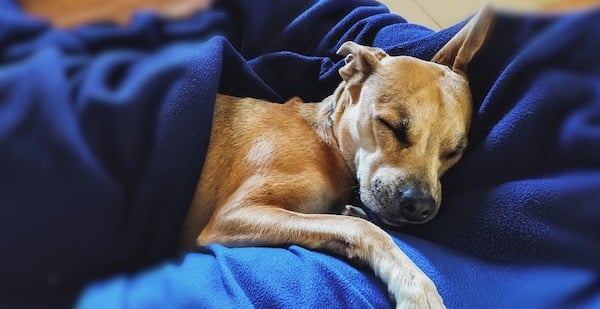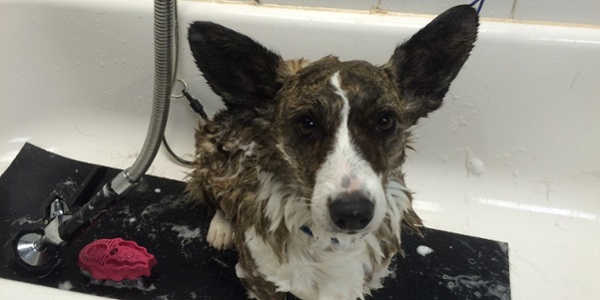- en
Your dog has an ear infection! Now what?
This pet information prescription will help you know what to do, how to make your dog more comfortable, and how to prevent this from happening in the future.
Quick Links

Why does your dog do a full-body shake every once in a while? Is it normal? Yup, it is. When a dog does its "shake," it's a sort of "re-boot" or reset — to start fresh. Perhaps their fur is out of place, they're wet, or something has caused them stress, and they're re-setting and moving on. If your dog frequently shakes, though, it could be a medical problem, like an ear infection, so consult a veterinarian.
Our mission is to help save dogs' and cats’ lives through our educational content. To support our efforts, this page may contain affiliate links. We earn a commission for qualifying purchases – at no cost to you.
The most common type of ear infection in dogs is known as otitis externa. It is the inflammation and infection of the external ear canal’s lining. Otitis externa can be a primary or secondary disease process. Its causes can be multifactorial, making it difficult to make a diagnosis and treatment at times. The pinna (ear flap) and inside the ear may be red, swollen, and there could be a foul smell. Some people think it smells like corn chips – this is the smell of the yeast overgrowth. The ear canal can have either a dark brown or yellow discharge. On occasion, they are a result of an ear mite infestation.
Your dog could've gotten an ear infection:
 Because your dog may be painful, there is an increased risk of them biting or nipping as a defense mechanism, particularly if their ears are touched. Be sure that any children in the home are aware that your dog may be more sensitive around their head and ears, and don’t leave them together unsupervised.
Because your dog may be painful, there is an increased risk of them biting or nipping as a defense mechanism, particularly if their ears are touched. Be sure that any children in the home are aware that your dog may be more sensitive around their head and ears, and don’t leave them together unsupervised.
Be aware of your dog’s possible discomfort when cleaning or treating their ear infection. If you aren’t able to do so safely, stop and talk to your veterinarian about the next steps.
Untreated ear infections may eventually lead to hearing loss, changing the way you and your family communicate with your pet.
Follow your veterinarian’s instructions to medicate and/or clean your dog's ears. Only do the things in the list below if your veterinarian instructed you to since different infections require different types of cleaning or no cleaning at all.
Based on the type of ear infection and the medications prescribed, your dog may need:

If your pet is feeling a lot of pain, it may be wise to muzzle your dog to protect yourself from a bite.
Making the activity of cleaning your pet's ears enjoyable is an excellent goal to have. Because once their ear infection is cleared up, you'll want to do regular ear maintenance – cleaning once a week if possible.
ALWAYS clean your pet’s ears after a bath or swimming and when they return from the groomers. This type of cleaning isn’t as involved as when an ear infection is present. If you are using an ear cleaner with a cleaning and drying agent, such as Otiderm®, for post bathing/swimming times, just overfill the ear canal with cleaner and massage. BOOM! You are done!
The best thing you can do is use the medication your veterinarian prescribed and follow their directions for cleaning (but only if they have recommended this).
Make sure to use the medication for the entire length of time prescribed, even if your dog feels better in a day or two. This is important to make sure the infection is fully treated — and doesn’t come back! Avoid touching or rubbing their ears (except for cleaning) until their infection goes away since this may be uncomfortable for them.
It is highly recommended that you have your pet rechecked just before finishing medications to be sure the infection is cleared.

You should notice a decrease in your dog scratching and shaking their head. Your pet’s ear should look less red, and the odor should be getting better.
If you're cleaning their ears, the stuff coming out should eventually be a clear or light brown color.
If your pet is still uncomfortable with no decrease in scratching or shaking after 3–5 days of treatment, you should call your veterinarian and let them know. After a week, if you're still seeing dark brown debris on the gauze pad when you’re cleaning their ears, this also means that the infection is likely still present. If your pet suddenly develops a head tilt to one side or the other, stop all cleaning and medication and get them to a veterinarian right away.

Ear infections often happen after a bath or swimming, when water gets trapped in a dog’s L-shaped ear canal. Try to avoid getting water in their ears during a bath. Don't pour water over their head or use the shower nozzle – use a wet face cloth or sponge instead. It's also helpful to put a piece of cotton ball in their ears before a bath, but make sure to remove it right after!

If you think water got in during a bath, or when your dog goes for a swim, be sure to use an ear cleaner with a drying lotion to make sure any moisture that got into their ear canals will disappear. A veterinarian can recommend the proper ear cleaner to use.
If your pet has long hair on the inside of their ears, it can sometimes help to flip their ear flaps back to allow for some air circulation. It often will help to keep the inside flap and area below the base of the ear canal trimmed short. For those pups with hair inside their canals who have had repeat ear infections, having the groomer pluck their ear hair may help, but this is only recommended for pets with a history of ear problems.
The Pet InfoRx® is made possible, in part, through our partnership with AlignCare®.


© Preventive Vet. All rights reserved. PreventiveVet.com
